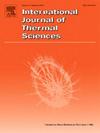Development and experimental validation of a two-dimensional CFD model for narrow rectangular channel simulations
IF 5
2区 工程技术
Q1 ENGINEERING, MECHANICAL
International Journal of Thermal Sciences
Pub Date : 2025-06-27
DOI:10.1016/j.ijthermalsci.2025.110114
引用次数: 0
Abstract
The coolant flowing through the narrow rectangular channel delivers efficient cooling for the plate-type nuclear fuel assembly. These narrow rectangular channels are typically closed and differ significantly from the coolant channel geometry in conventional fuel rod assemblies. To accurately model the coolant behavior within these channels, a computational fluid dynamics (CFD) model was developed and validated in this paper. A two-dimensional (2D) mesh was employed to approximate the three-dimensional (3D) coolant flow, thereby reducing computational complexity. Conservation equations were formulated, and a void fraction model was incorporated as an auxiliary component. The model was validated by comparing calculation results with experimental data from the literature. In addition, to further investigate the coolant flow distribution, a multi-channel experiment was conducted to obtain additional validation data in this study. The verification results for the heat transfer, coolant flow, and void fraction models demonstrated satisfactory accuracy. The maximum absolute error of the coolant temperature was 3.1 K, and the pressure drop had a maximum relative error of 1.81 %. Under conditions of supercooled boiling at atmospheric pressure, the average relative error in void fraction was 18.24 %. Based on the multi-channel experimental data, the maximum relative error in flow distribution was 14.03 %. In multi-channel simulations, neglecting the heat conduction of steel partitions was identified as a significant source of error. Therefore, accurately modeling the coupled heat transfer between the steel partitions and the coolant is essential for improving simulation accuracy in future research.
窄矩形通道二维CFD模型的建立与实验验证
冷却剂流经狭窄的矩形通道,为板式核燃料组件提供了有效的冷却。这些狭窄的矩形通道通常是封闭的,与传统燃料棒组件中的冷却剂通道的几何形状有很大不同。为了准确地模拟这些通道内冷却剂的行为,本文建立了计算流体动力学(CFD)模型并进行了验证。采用二维网格来模拟冷却剂的三维流动,从而降低了计算复杂度。建立了守恒方程,并引入了孔隙率模型作为辅助分量。将计算结果与文献中的实验数据进行比较,验证了模型的正确性。此外,为了进一步研究冷却剂的流动分布,本研究还进行了多通道实验,以获得额外的验证数据。传热、冷却剂流动和空隙率模型的验证结果显示了令人满意的准确性。冷却液温度的最大绝对误差为3.1 K,压降的最大相对误差为1.81%。在常压过冷沸腾条件下,孔隙率的平均相对误差为18.24%。基于多通道实验数据,流量分布的最大相对误差为14.03%。在多通道模拟中,忽略钢隔板的热传导被认为是误差的重要来源。因此,准确地模拟钢隔板与冷却剂之间的耦合传热对于提高今后研究的模拟精度至关重要。
本文章由计算机程序翻译,如有差异,请以英文原文为准。
求助全文
约1分钟内获得全文
求助全文
来源期刊

International Journal of Thermal Sciences
工程技术-工程:机械
CiteScore
8.10
自引率
11.10%
发文量
531
审稿时长
55 days
期刊介绍:
The International Journal of Thermal Sciences is a journal devoted to the publication of fundamental studies on the physics of transfer processes in general, with an emphasis on thermal aspects and also applied research on various processes, energy systems and the environment. Articles are published in English and French, and are subject to peer review.
The fundamental subjects considered within the scope of the journal are:
* Heat and relevant mass transfer at all scales (nano, micro and macro) and in all types of material (heterogeneous, composites, biological,...) and fluid flow
* Forced, natural or mixed convection in reactive or non-reactive media
* Single or multi–phase fluid flow with or without phase change
* Near–and far–field radiative heat transfer
* Combined modes of heat transfer in complex systems (for example, plasmas, biological, geological,...)
* Multiscale modelling
The applied research topics include:
* Heat exchangers, heat pipes, cooling processes
* Transport phenomena taking place in industrial processes (chemical, food and agricultural, metallurgical, space and aeronautical, automobile industries)
* Nano–and micro–technology for energy, space, biosystems and devices
* Heat transport analysis in advanced systems
* Impact of energy–related processes on environment, and emerging energy systems
The study of thermophysical properties of materials and fluids, thermal measurement techniques, inverse methods, and the developments of experimental methods are within the scope of the International Journal of Thermal Sciences which also covers the modelling, and numerical methods applied to thermal transfer.
 求助内容:
求助内容: 应助结果提醒方式:
应助结果提醒方式:


